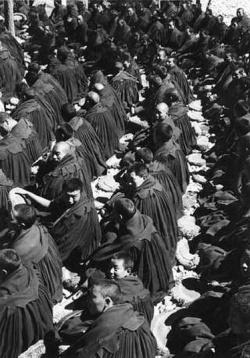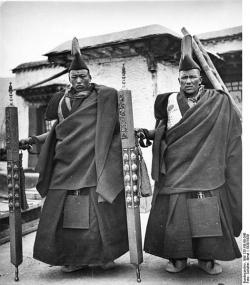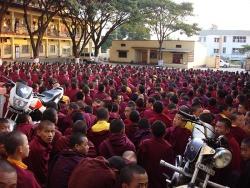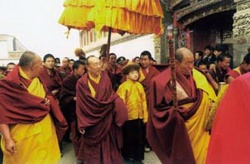A Lama’s life in the Monastery
The World knows Tibet boasts numerous Monasteries and lamas. However, many in the World have no idea as to how lamas fare in these Monasteries. I have been studying this very subject for decades.
In the late autumn of 1985, I went to Gangdelin Township in the western suburbs of Lhasa to visit my friend Qambalhasang. As luck would have it, he had driven his tractor to the nomadic area of Damxung to buy cattle. Yexei Tangsang, his uncle, who was a Lama with the Zhaibung Monastery but has already resumed secular Life, greeted me enthusiastically. Sitting in the newly-built Tibetan-style building, we sipped buttered tea while enjoying looking out through the big glass window at the sun setting. Bathed in the sunlight of dusk, all the white buildings in the Zhaibung Monastery were dyed red. It was in such a Mysterious environment that Mr. Yexei Tangsang told of his Lama Life in a low, deep voice.
Tonsured to the Loseling Monastery
Yexei Tangsang was born into a Monastery serf family. At seven, his father pleaded with the manor Lord for Yexei to be tonsured to the Loseling Monastery. He won permission from the Monastery on the prerequisite that, when Yexei eventually resumed his secular Life, he had to return to the manor to continue working as a slave. This was called “a rabbit returning to his warren”.
Yexei followed his father into the labyrinthine Zhaibung Monastery. He walked almost on tiptoe shyly, and registered with the Tsangba Kamcun (Sutra-studying organization). His uncle shaved his head, leaving only a tiny handful of Hair at the top, and brought him to the Kampus abbot in charge of the Tsangba Kamcun.
The abbot, sitting high up in his throne, asked: “Are you willing to become a Buddhist?”
“Yes.”
“Are you happy to do this?”
“Yes.”
The abbot prayed and chanted several sentences of the Scripture, took the scissors to cut off the last lock of Hair and gave him his religious Name of Yexi Tangsang. Yexei was the first Name of the abbot. All of the Monks he tonsured adopted it.
If we say the Zhaibung Monastery is a university, Monk institutions are colleges attached to the university and Kamcun is a department. Yexei, and others who entered the Monastery at about the same Time, stayed in the same class. They were taught Tibetan pronunciation, grammar, and Words of Prayer before delving into the study of the five volumes of Buddhist classics. Some in Kamcun didn’t have to study. Called Toto Lamas, they were charged with energy consuming services. They showed special Interest in sports and often fought. Yexei didn’t follow that road. He studied the scriptures diligently and made progress following the prescribed Order. As a result, he was listed into the rank of Sutra students in his class, called Bechawa in Tibetan.
Drinking Tea and Praying
As Venus began to show in the dark sky, the Monk dorms were pitch dark. When one could see the veins on his palms in the open air, a strong Monk called Mimi Cewa climbed up to the highest point of the Main Hall of the Zhaibung Monastery, beating his palms three Times and shouting in a deep voice from his thoracic cavity: “Mimi Cewa Deqin Gyairasi!’ (Blessings from the Goddess of Mercy). Then, a little Lama aged 12 or 13 shouted with crispy voice: “Toinba-Danggar-Sio!’ (Time to Chant scriptures). They repeated this three Times. Their shouting spread into each room of the Monastery.
On hearing the shout, Monks got up and ran to the Coqen Hall striving to be the first and fearing to lag behind. Coqen is a place where the Monks gather for collective Chanting of the Buddhist scriptures. In the Coqen, whose roof is supported by 183 huge pillars, about 10,000 lamas in Dagang (Buddhist shawls) were seated in rows. The walls were illuminated by hundreds of butter lamps. Monks prayed while sipping their morning tea. In Tibetan, this routine morning Prayer is called Mamcha (Tea Party for All Monks). The Prayer lasted until all had declared the completion of their breakfast.
The morning Prayer was hosted by the Sutra Reciting Master or Wongtse as the Tibetans call him. He was somewhat like a conductor of a band who, however, also Sang. He was very familiar with Buddhist scriptures and had a well-trained voice. He led the Chanting in a male bass with very good resonance: “Gongqoi Soiqoi Bapa” (Paying sacrifices to the Three Treasures). All Monks echoed him and finished their first bowl of buttered tea. Since the hall had good acoustic resonance, the Sound of Chanting and the slurping of tea sounded like raging waters. This Ritual was repeated three Times before all the Monks put zanba (roasted highland barley flour) they had taken with them into their wooden bowls containing leftover buttered tea. They chanted while making and eating the zanba dough.
At noon, Monks gathered in the Sutra Hall of their respective study institutions, drinking tea and praying in a similar manner but on a smaller scale than the morning mass. In Tibetan, this is called Zacha, meaning “tea party in the study institution”. The Loseling Study Institution beat gongs to gather Monks while other institutions blew sea conches or souna horns. The Sound of the gong beating lasted 15 minutes, long enough for lamas living in the farthest room to hear.
Evening Prayer was held in various Kamcuns, Sutra study organizations on much smaller scale. It was called Kamcha in Tibetan or Kamcun Tea Party. The Kamcun to which Yexei belonged always beat rocks to gather the Monks for their Prayer party. Rocks used for this purpose were unique to Tibet. Called Dodi in Tibetan (which I translate as Sound Stone), it gives out a Sound one normally associates only with metals.
Whatever the Time of day, there would be people present to give alms in the Form of cash or tea porridge. They did so for various reasons. In most cases, they did so because they had relatives who had died and, therefore, needed to invite lamas to Chant Sutras to redeem the sins of the deceased so that he or she could return to the World again to lead a better Life. After the Prayers, the Monastery bailiff stood at the gate while Monks left, receiving cash alms from the benefactor.
Apart from the three sets of daily Prayers, lamas with the Zhaibung Monastery also had to debate on Buddhist scriptures three Times per day in the courtyard. On these occasions there was no tea to drink and no zanba to eat, so the sessions were known colloquially as ?hanting Drying Scriptures’.
Each study institution had its own courtyard with stone walls and green Trees to provide shade. After the morning Prayer, Monks, wearing the red kasaya that glowed in the sunlight, swarmed into the courtyards, where they sat on the ground. Prior to the debate, called Xiaoqoi in Tibetan or “Morning Sutra Debate”, Wontse led a Sutra recitation. This lasted until the Gegui (law-enforcing Lama) threw his kasaya backwards to signal an end. Bechawa Sutra students then began practicing Sutra debate, which was called Tanggyai, while those who did not study Sutras, especially the Toto lamas, left for games.
The abbot took part in the noon Scripture debate (Nyingqu). After the law-enforcing Lama had called the roll, the abbot gathered together the Monks from various classes, giving them sample tests or guidance. This was followed by group debate practice. Each group was composed of two Monks, one sitting and the other standing, one asking and the other answering. The questions and answers were accompanied by vivid hand gestures, clapping and shouting.
This lasted even after sunset. The third debate practice of the day was called Gugyi Zeba. This was open to Monks on a voluntary basis. Those who studied very hard and tried to penetrate the mysteries of the five volumes of Buddhist classics practiced even in the biting cold very late at night, while others sipped tea or slept in their respective dorms.
However, such debate practice was not held every day. In the summer, it was held every 15 days, but each Time lasting as long as 15 days. Staying-in Summer
Winter in Lhasa is so prolonged that Spring is still very cold. It is so windy and dusty that it is hard to open one’s Eyes in the open air, and Plants refuse to sprout and birds and worms refuse to hatch until early summer. During this period, the Zhaibung Monastery forbade its Monks to leave the Monastery for fear that they would go against Buddhist rules and thus would not be able to become a Buddha by stepping on, and thus killing or wounding, newborn worms and nestling birds.
From the 15th day of the sixth Tibetan month to the 30th day of the seventh Tibetan month each year, all the Monks are required to stay in the Monastery, a practice called Yaleg, meaning “staying inside the Monastery in summer.’ On the first day of Yaleg, which falls on the 15th day of the sixth Tibetan month, Monks of the Zhaibung Monastery gathered in the Coqen Hall to take an oath under the Leadership of the abbot: “Do not go out. Do not Kill living things.”
This was followed by the Yadaba (Discipline Lama in charge of “staying inside the Monastery in summer’), carrying a giant iron lock and key, who passed in front of Monks so that each could place his hands on the implements and recite the words of oath. From then on, his actions were limited by the oath and the relationship between lock and key. Anyone who went against the oath would be punished severely by the Deities and Buddha. To tighten the rule, the Yadaba Lama was authorized by the Dalai Lama not to shut himself inside the Monastery during these days. He was able to roam around here and there. If he came across any Monk from the Monastery, the latter would be fined or whipped.return
Every day, after morning Prayer, all Monks returned to their own dorms for in-door study. They put a mud ball and a handful of grass on the door, meaning they were in a “brown study” and no one should disturb them. If anybody had something regarded as important enough to justifying going outside immediately, permission was required from another Lama who, however, could not be the Gegui Lama in charge of Discipline or the master or senior Monk. He might leave for seven days at most. If he did not come back within the stipulated Time, he would be considered to have gone against the taboos, and the Lama who gave him permission to leave would also be held responsible for violation of the Monastery rules.
During the “staying inside the Monastery in summer”, abbots of the three study institutions named Luoseling, Deyang and Goma treated in turn all the Monks to butter tea and porridge. The abbot of the Aba Tantric Study Institution was not involved in this because he entertained all the Monks before the advent of the Ghost-dispelling Rituals during the Molangqenbo Grand Summons Ceremony in the first Tibetan month.
Shoton Festival in Zhaibung Monastery
During the “staying inside the Monastery in summer”, the Shoton (Sour Milk Drinking) Festival was held, when lay people would present sour milk to the Monks. This is a practice which has been carried out ever since the 11th century when Atisa (982-1054), an Indian Monk, promoted Buddhism in Nyetang, some 20 km southwest of Lhasa. He encouraged local people to present sour milk to lamas, claiming it would help livestock stave off plague and attacks by wild Animals.
The Zhaibung Monastery held the Shoton Festival on the 30th day of the sixth Tibetan month each year. This was a day in history when the 5th Dalai Lama was tonsured and also a day for one Discipline Lama to turn over his Power to another. The Zhaibung Monastery would invite six white-mask and four blue-mask Tibetan Opera Troupes, hailing from various parts of Tibet, to perform. Thousands of Buddhist followers and worshipers, as well as patrons of various other Monasteries, would come for the performance and give sour milk to lamas.
Legend has it that the Spirits were unhappy with lamas staying inside the Monastery for study and mediation during summer, and would do their best to make trouble. Seeing lamas drinking sour milk and entertaining themselves with performances, they were happy that these lamas were no longer studying. Content with the change, they would leave the Zhaibung Monastery and make trouble elsewhere.
The Staying-in period lasted until the 30th day of the seventh Tibetan month. By then, it was already at the end of the summer, with the nestling birds and newborn worms having grown up. Since they could run and fly, there was no longer any fear the lamas would hurt or kill them.
Immediately upon their release, the Monks would go directly to visit the Dalai Lama in the Norbu Lingka, his summer palace. The Dalai Lama would give them a Blessing touch on their foreheads and tie a Qendui (talisman rope) around their necks. The abbot on duty in the Monastery would produce Mandra (Mandala in the shape of a dagoba) and, while other Monks were Chanting well-wishing Prayers, presented it to the Dalai Lama and wished him a long Life. This was followed by Nejoin, the chief wizard In Tibet, working to invite Deities to descend.
Monks with the Zhaibung Monastery would enjoy a 15-day leave beginning on the first day of the eighth Tibetan month. Many Monks would go visit lingka woods outside the Monastery. Among them was the Gyiling Lingka to the west. Tucked away at the foot of a mountain, it is a peaceful environment featuring luxuriant Trees and grass. The chief abbot of the Zhaibung Monastery would attend the festivities. To the east is the Gyangza Lingka. Located in a sweep of Lhasa flat land, it was a public park for all Monks with the Zhaibung Monastery. Monks with the Nejoin Monastery would also come to the woods for more than one month of relaxation. During the month-long leave, they were free to take baths, entertain themselves with picnics, play cards and dice called Xo in Tibetan, sing, dance and perform Tibetan Opera items they had created. Toto lamas would exploit this chance to their practice martial arts and enjoy sports. Giving Alms of Tea Porridge
Monks with the Zhaibung Monastery took it for granted to live on tea porridge given as alms. Although this happened all year round, it was given mainly in winter because Monks who had been studying hard for 20 or 30 years had gained a good command of the five volumes of Buddhist classics. Some of them had passed Sutra Debates held many Times for them and thus had won the Geshi title, which is the highest Buddhist study degree In Tibet. These new Geshi holders asked their relatives or patrons to give alms in the Form of tea porridge to the Monastery lamas. In Tibetan, this is called Guncha Qengpo meaning “granting tea porridge alms in winter.” It is also called Tuba Mingda in Tibetan meaning “porridge feast given by new Geshi holders”. With this done, one’s Geshi degree was recognized by the Monastery. What one had to do was to wait for the Molangqenbo Grand Summons Ceremony to be held in the Jokhang Monastery, also in Lhasa. During the ceremony, names of new Geshi holders arranged in accordance with their performance would be announced.




